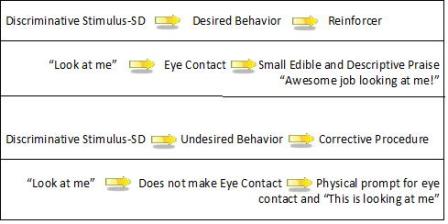Discrete Trial Training used in ABA Autism Therapy
Learn about one of the best autism treatments called discrete trial training (DTT), as a method of applied behavior analysis (ABA). Also referred to as Discrete Trial Instruction (DTI), this form of ABA autism therapy, is used to establish necessary behaviors for day to day functioning.
Behaviors are determined by each child's own unique and individual needs. Usually starting with eye contact and imitation, children will then typically progress to learning how to use PECS pictures for communication and academic skills.
Discrete trial training is most effective when applied on a daily basis for large amounts of time and started in the preschool years. Repetition is a main attribute for helping children acquire new skills.
Generally, a specific training program would be written for each behavior determined as essential for the child to learn. As part of that program there would be a designated instruction, also referred to as the discriminative stimulus, and a defined behavior for the child. The instruction must be clear, concise, and short to aid in the child’s learning.
Example of DTT
For example, if you wanted the child to make eye contact; you would start with an instruction of “Look at me.” Initially, this may require prompting on the trainer’s part to get eye contact.
Once the desired behavior is performed as outlined in the program, the child is immediately (within ½ second) presented with a reinforcer. Reinforcers are things such as a small piece of preferred food, favorite toys, social interactions, verbal praise, or social play all dependent on that specific child’s preferences.

If the desired behavior is not completed during a discrete trial as outlined in the plan, the trainer would execute a correction procedure. This would involve making a statement in a corrective tone of voice, such as “This is looking at me.” While gently guiding the child’s face toward the trainer and ensuring that eye contact is made if only for a brief second.
A series of the discrete trials may continue for 10-20 times consecutively. Data is collected for each trial and a calculated percent correct at the end of the series is used to determine whether the child is ready to move on to the next phase for that behavior. For eye contact, the next training phase may be simply giving the instruction of the child’s name, “Tommy.” with the desired behavior of eye contact.

Rate of Progress with Discrete Trial Training
Each child’s rate of progress varies, but the more hours devoted to the use of discrete trial training and applied behavior analysis, the higher the success rate.
While initially the trainer would probably complete the training in a structured environment with minimal distractions, it would also eventually be used in a more relaxed manner while engaging the child in a preferred activity, such as playing at the park.
While engaging in normal play, the trainer would give the instruction “Look at me.” or “Tommy.” with the expectation of the child making eye contact and following through with a reinforcer or correction procedure.
It would also be good to complete series of trials with different trainers as well. This helps to generalize and maintain the behaviors in other environments with other people.
While this treatment option has a good evidenced based outcome, I believe to ensure progress, it is important to create a good foundation for the child to be able to learn through this technique. When the use of biomedical treatments for autism and the proactive strategies outlined in my free eBook Child Behavior Guide: What you need to know are in place, it will help to increase a child's success rate with discrete trial training.
Return to ABA Autism Treatments page
Return to Home from Discrete Trial Training page